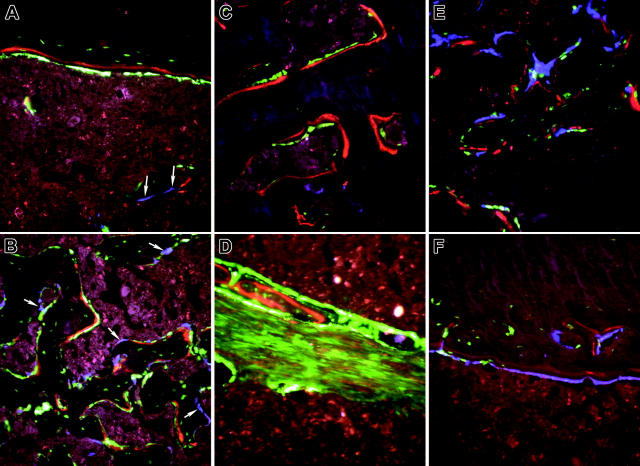Figure 6.
High-power images of bone from nontransgenic recipients of an intramedullary injection of calvarial stromal cells. (A-B) Calvarial progenitor cells from a 2.3-green donor mouse injected into a nontransgenic recipient and rescued with TMB from a 3.6-blue donor. Selected images (original magnification, × 200) show engraftment of diaphyseal bone (A) and formation of new trabecular bone (B) and illustrate the association of XO label with 2.3-green cells. Because the 2.3-green marker gene remains active in osteocytes, marked donor cells become incorporated into the host bone and within the newly formed trabecular bone. In contrast, the 3.6-blue cells (arrows) remain on the bone surface and are not associated with the XO label. These images are obtained from the scan shown in Figure 7A. (C-D) Calvarial progenitor cell from a 3.6-green donor mouse injected into a nontransgenic recipient that was rescued TBM from a 3.6-blue donor. Selected images (original magnification, × 200) show engraftment of pre-existing bone (C) and formation of new trabecular bone (D) that appears to be derived from the fibroblastic tract. Both structures exhibit donor-derived osteoblasts (strong GFP signal) in association with the XO label. The fibroblastic-shaped cells along the injection tract are not associated with bone mineralization and run between regions that have produced trabecular bone. These images are obtained from the scan shown in Figure 7B. (E-F) Nondecalcified sections of a femur showing engraftment of 3.6-blue donor-derived calvarial cells after injection into a 3.6-green host that was rescued with nontransgenic TBM. (E) Trabecular region. (F) Cortical region. In both images there is commingling of 3.6-blue donor and 3.6-green host cells on the bone surface that is associated with the XO label.

